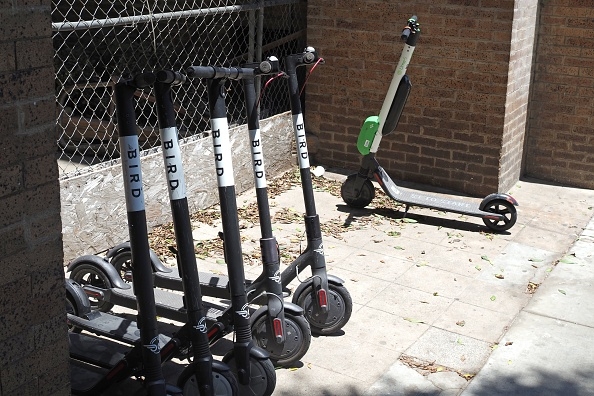You have /5 articles left.
Sign up for a free account or log in.

Getty Images
Dockless electric scooters are filling a transportation gap for students, who have quickly taken to using the app-based, pay-as-you-ride scooters to get around many campuses. A happy medium between bicycle and car, the new technology has brought convenience to students as well as confusion for college officials, who are figuring out how best to accommodate the scooters while addressing potential safety and accessibility issues.
“The interesting thing about electric scooters is that they’re similar to other types of transportation in many ways,” said Melanie Bennett, risk management counsel at United Educators, “but unlike bicycles and skateboards, because the scooters are propelled, they can reach speeds up to 20 miles an hour. However, unlike other forms of motorized transportation, they don’t surpass those speeds.”
So, where is it appropriate to ride them? And because they are dockless, where should they be parked?
Miami University in Ohio is working to answer these questions after hundreds of scooters from Bird and Lime, two popular e-scooter companies, debuted in Oxford, Ohio, this fall. In July, the university banned the scooters from campus, and David Creamer, senior vice president for finance and business services at Miami, wrote a letter to the City of Oxford and to Bird Rides Inc. to stress that the university would not be liable for any scooter misuse on campus.
“The university will not assume and expressly denies any responsibility or liability for any damage to e-scooters that may be present on university property. Similarly, the university will not assume and expressly denies any responsibility for any property damage, injuries or deaths caused by e-scooters,” Creamer wrote. “Since it appears the city is encouraging the use of e-scooters by Miami University students and employees, we expect the city and Bird Rides Inc. are fully prepared to accept all legal and financial responsibility for the use or misuse of e-scooters.”
Samantha Brunn, a student at Miami University who has written about the e-scooter debate for the Miami Student, said that students were upset about the ban.
“When the initial policy was passed in July, most well-connected student on campus, like those on the student newspaper or student government, were really upset … because students weren’t on campus to have a say in that decision,” she said.
Soon after Bird debuted its 100-scooter fleet in Oxford, the university amended its Use of Bicycles and Transportation Devices policy to allow e-scooters on campus under a series of conditions, including that riders must walk the scooters on sidewalks, ride them in campus bike lanes and park them at bike racks.
“The City of Oxford contracted with two electric scooter vendors, so they’re here,” said Claire Wagner, director of university news and communication. “But we, out of concern for safety, put out rules about where they could or could not be used on campus.”
Indiana University at Bloomington also requires e-scooters to be parked in bike racks. Michigan State University prohibits it and requires that students park their e-scooter in a metered parking space or obtain a moped parking permit.
But students don’t always follow those rules, which results in many scooters spending days (or weeks) in the slammer. Miami University has impounded more than 25 scooters from Bird’s relatively small fleet. Indiana University has impounded more than 150 scooters in the past 20 days, and Michigan State University impounded 176 scooters. Of those impounded at Michigan State, only nine have been released. The University of Texas and the University of Georgia are also impounding scooters.
The scooter company can retrieve the scooters for a fee, which varies from campus to campus and based on where the scooter was parked. At Indiana University, a scooter found left in landscaping could cost $40-$50 to retrieve, while a scooter parked in a pathway or ramp mandated by the Americans With Disabilities Act could cost upwards of $100 to get back. To collect hundreds of impounded scooters could cost a company thousands.
Bird and Lime, as well as the universities, offer safety guidelines for riders, but students are not so good at following them.
“People were concerned that students wouldn’t be wearing helmets or wearing heavy backpacks,” Brunn said. “I haven’t seen a single person wear a helmet while riding it. I have seen multiple kids wearing backpacks, but that’s to be expected on a university campus where students are riding them to class.”
She also expressed some concern that students would ride the scooters drunk, which could land them with an OVI -- “operating a vehicle while intoxicated” charge -- but the scooters shut off at 9 p.m. each night to be collected and charged, well before most students typically head to the bars.
Bennett, of United Educators, recommends that universities have some kind of transportation policy.
“If you don’t have a policy in place and you’re starting to see the traffic on campus, it’s a good time to put a policy in place just to create parameters around e-scooter use,” she said. That policy should detail where the scooters can and can't be used, where they should be parked, and if there are any speed limits or safety requirements.








